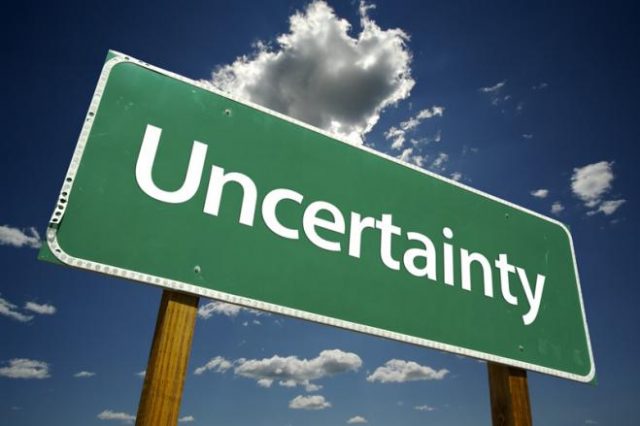Embracing Uncertainty – 10 mins read
I was lucky enough to attend an agile conference where the keynote speaker was Dan North. This is my interpretation of his talk, enjoy.
Who is Dan North?
Dan has been coaching, coding and consulting in software delivery for over 20 years. He’s a great speaker and his website is full of amazing material and case studies. Dan has a wealth of knowledge and some of his comments are so deep I wish I could pause him for a minute to digest what he just said.
Managing Uncertainty
Kent Beck, when he wrote his first book, Extreme Programming, talked about embracing change; but Dan argues that what he really meant was to embrace uncertainty of scope. The core of most industries does not change, for instance banking doesn’t change – it’s about the movement of money: the environment that the core industry works in is in constant change. To survive as an industry you have to be able to change and adapt and embrace uncertainty. There is a concept of bounded and centred communities that Dan talked about. The way I imagine the difference:
1) A centred community: in my recent travels to Mombasa I went on safari and took this picture, which reminds me of a centred community. [Warning holiday snap below] Tsavo East
The waterhole is where elephants congregate, and there are very few boundaries or rules. When rain is plentiful the elephants will venture further afield, however they will always return back to the waterholes when water is scarce. The centred workplace is where teams work collectively on a core purpose and have common values (waterhole). The team are not bounded by rules and will venture, explore options and gain rapid feedback. They work well with uncertainty and collectively adapt to any situation.
2) A bounded community:
[Another holiday snap! Last one I promise].
David Attenborough could explain a bounded community of lions better than me I’m sure, but here goes… Essentially the lions live by a set of rules and boundaries. The male lion will rule the pride and fend off any threats that try to change the balance of power. In the workplace the team works within boundary markers that give them a sense of belonging and structure. Leaders prescribe rules and boundaries and fend off threats, and this gives us the feeling of comfort and safety.
So why are bounded communities the status quo? One of the reasons Dan gives is the fear of uncertainty.
We would rather be wrong than be uncertain.
Throughout history humanity has used boundaries and rules to manage uncertainty: we have become accustomed to interpreting complex problems with simplistic answers. Anyone who is going through agile transformation will see this; where the silver bullet to all problems is to become agile. The interpretation of the problem becomes dogma. What we do is take the simplistic answer and forget to solve the problem. Answers such as lean principles, flow, theory of constraints are all important; however what is more important is understanding what works in reality, not just in theory.
We tend to manage:
-Uncertainty of scope by producing rigid scoping documents that are signed off as gospel.
-Uncertainty of technology by using toxic measures such as cost of use, and prescribing rigid strategic architecture.
-Uncertainty of effort by pushing for 100+% utilisation, crippling throughput and flow.
-Uncertainty of structure by putting a management control structure in place instead of enabling flow which is the essence of management.
-Uncertainty of the future by creating detailed project plans based on fictitious dates.
How can we manage uncertainty?
Dan talked about practical frameworks to manage uncertainty
1) Deliberate discovery: the team hits the hardest part of the problem first to drive discovery. They work to surface uncertainty early by choosing to work on things they know the least about. Imagine any project you have delivered in the past. The Doc, in true Back to the Future style, takes you back to the start and you could begin this project again with all the learning you now have. How much quicker could you deliver the project? Maybe in half the time? Unfortunately there is no flux capacitor just yet, so you have to remember that ignorance is your biggest constraint (you don’t know what you don’t know). Using deliberate discovery you start to uncover what you do not know, reducing your ignorance through learning. A great blog to read about reducing uncertainty is by Dave Snowden.
2) Real options: Each time you come across uncertainty you have an option to make a decision. People who crave certainty will tend to make decision far too early based on little logic. The basic principle of real options is making the decision at the last responsible moment where you have as much information as possible. The key word here responsible allowing people to make the most optimal decision within the context of time and information. This article by Chris Matts and Olaf Massen provide more insights into real options.
3) Rolling wave planning: rolling wave planning embraces uncertainty of scope. Rolling wave planning is when you plan the project in waves, where you deal with the most certain things first and as the project proceeds the uncertain details become clearer. Dan talked about a concept of boulders, rocks and pebbles where you work with the pebbles and put the discovery processes in place to change the boulders into rocks into pebbles so they can be dealt with. Instead of creating a plan that looks amazing but is based on fiction, it is better to guess how long it will take by discussing the scope with experienced individuals. In every project update meeting you simply argue the hypothesis each time and say, “do we still believe we can deliver in x months?”. As time goes by we either get more certain, or less certain of the delivery. Our trust is the ability to prove our hypothesis and we focus on how much have we left to do, rather than how much we have done.
Conclusion
I hope the above insight provides you with some practical tools you can use to embrace uncertainties of scope, technology and effort. If you can frame your mindset so that you can accept that some bad things will happen, that it’s no one’s fault and it’s unpredictable, you will be equipped to adapt to uncertainty. Embrace uncertainty as it’s inevitable: it will never go away so you have to change your relationship with it to be successful.




3 comments
And this reflection makes me think about a claim I read today: your strategy was right when you made it. But that was yesterday.
Love that quote. I will be using it. Agree strategy has a use by date which is normally as soon as you print it out and present it!
Another eye-opener. And very timely as we’re dealing with LARGE doses of uncertainty in the current project.
You article has got me thinking…
Who knows, it may point us a path our thought process hasn’t ventured into, yet.
And thanks for providing all the external links in there – much appreciated.